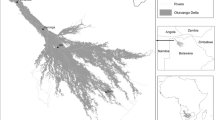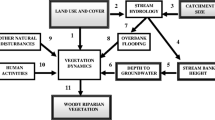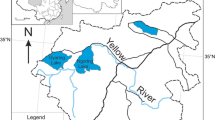Abstract
Vegetation of wetlands adjacent to headwater streams on the Kenai Lowlands was dominated by Calamagrostis canadensis, indicating that it is a keystone species that influences stream-wetland interactions across a wide range of geomorphic settings from which headwater streams have their origin. We sampled 30 sites as part of a project to determine the relationships between landscape features and the biological and chemical characteristics of headwater streams and their associated wetlands. In this paper we consider vegetation in wetlands adjacent to headwater streams. Calamagrostis canadensis was the only species that occurred at all sites and only a few species were widespread and abundant across the range of sites sampled. Nonmetric multidimensional scaling of species importance values indicated that the distribution of sites and species was primarily related to stream-reach scale environmental and biological factors. Sixteen stream-reach factors were significantly correlated with the distribution of sites and species on one axis of the ordination. Headwater streams that were located in relatively flat areas with extensive wetlands had species characteristic of nutrient poor wetlands and sites located in steep valleys with narrow wetlands had species characteristic of uplands and wetlands on mineral soils. The distribution of sites and species on the second ordination axis was interpreted to be a response to biological interactions; primarily the negative relationship between C. canadensis and the diversity of other species. We concluded that large-scale watershed features of the landscape are less important than local scale factors in determining the characteristics of vegetation in headwater stream-wetland complexes in the Kenai Lowlands. There was no evidence, however, that differences in the stream-reach scale conditions across the study sites resulted in distinct plant communities associated with the headwater wetlands even though the headwater streams had their origin in different landscape settings.





Similar content being viewed by others
References
Benda LE, Hassan MA, Church M, May CL (2005) Geomorphology of steepland headwaters: the transition from hillslopes to channels. Journal of the American Water Resources Association 41:835–851
Binckley CA, Wipfli MS, Medhurst RB, Polivka K, Hessburg P, Salter RB, Kill JY (2010) Ecoregion and land-use influence invertebrate and detritus transport form headwater streams. Freshwater Biology 55:1205–1218
Boggs K, Strudy M, Rinella DJ, Rinella MJ (2008) White spruce regeneration following a major spruce beetle outbreak in forests on the Kenai Peninsula, Alaska. Forest Ecology and Management 255:3571–3579
Boucher TV, Mead BR (2006) Vegetation change and forest regeneration on the Kenai Peninsula, Alaska following a spruce beetle outbreak, 1987–2000. Forest Ecology and Management 227:233–246
Brinson MM (1993) Changes in the functioning of wetlands along environmental gradients. Wetlands 13:65–74
Compton JE, Church MR, Larned ST, Hogsett WE (2003) Nitrogen export from forested watersheds in the Oregon Coast Range: the role of N2-fixing red alder. Ecosystems 6:773–785
Dekar MP, King RS, Beck JA, Whigham DF, Walker CM (2012) Allochthonous subsidies from grass-dominated wetlands support juvenile salmonids in headwater streams: evidence from stable isotopes of carbon, hydrogen, and nitrogen. Freshwater Science 31:121–132
Devito KJ, Hill AR, Dillon PJ (1999) Episodic sulphate export from wetlands in acidified headwater catchments: prediction at the landscape scale. Biogeochemistry 44:187–203
Gracz M, Noyes K, North P, Tande G (2008) Wetland mapping and classification of the Kenai Lowland, Alaska. http://www.kenaiwetlands.net
Hangs RD, Knight JD, Van Rees KCJ (2002) Interspecific competition for nitrogen between early successional species and planted white spruce and jack pine seedlings. Canadian Journal of Forest Research 32:1813–1821
Helfield JM, Naiman RJ (2002) Salmon and alder as nitrogen sources to riparian forests in a boreal Alaskan watershed. Oecologia 133:573–582
Homer Soil and Water District (2012) http://www.homerswcd.org/projects/wetlands.php. Accessed 1-6-12.
Hultén E (1968) Flora of Alaska and Neighboring Territories; a Manual of the Vascular Plants. Stanford University Press, Stanford
Jackson BK, Sullivan SMP (2009) Influence of wildfire severity on riparian plant community heterogeneity in an Idaho, USA wilderness. Forest Ecology and Management 259:24–32
Janisch JE, Foster AD, Ehringer WJ (2011) Characteristics of small headwater wetlands in second-growth forests of Washington, USA. Forest Ecology and Management 261:1265–1274
Johnson D, Kershaw L, MacKinnon A, Pojar J (1995) Plants of the Western Boreal Forest & Aspen Parkland. Lone Pine Publishing, Vancouver
Karlstrom TNV (1964) Quaternary geology of the Kenai Lowland and glacial history of the Cook Inlet Region, Alaska. U.S. Geological Survey Profession Paper No. 443. Washington
Kiffney PM, Richardson JS (2010) Organic matter inputs into headwater streams of southwestern British Columbia as a function of riparian reserves and time since harvesting. Forest Ecology and Management 260:1931–1942
King RS, Walker CM, Whigham DF, Baird SJ, Back JA (2012) Catchment topography and wetland geomorphology drive macroinvertebrate community structure and juvenile salmonid distributions in southcentral Alaska headwater streams. Freshwater Science 31(2). doi:10.1899/11-109.1
Landhäusser SM, Lieffers VJ (1994) Competition between Calamagrostis canadensis and Epilobium angustifolium under different soil temperature and nutrient regimes. Canadian Journal of Forest Research 24:2244–2250
Landhäusser SM, Lieffers VJ (1999) Rhizome growth of Calamagrostis canadensis into mounds created for tree seedling establishment. New Forests 18:245–262
Landhäusser SM, Mulak TL, Lieffers VJ (2007) The effect of roots and litter of Calamagrostis canadensis on root sucker regeneration of Populus tremuloides. Forestry 80:481–488
Leopold LB, Wolman MG, Miller JP (1964) Fluvial processes in geomorphology. Dover Publications
Lieffers VJ, McDonald SE, Hogg EH (1993) Ecology and control strategies for Calamagrostis canadensis in boreal forest sites. Canadian Journal of Forest Research 23:2070–2077
Lowe WH, Likens GE (2005) Moving headwaters to the head of the class. Bioscience 55:196–197
Matsushima M, Chang SX (2007a) Nitrogen and water availabilities and competitiveness of bluejoint: spruce growth and folial carbon-13 and nitrogen-15 abundance. Soil Science Society of America Journal 71:1547–1554
Matsushima M, Chang SX (2007b) Effects of understory removal, N fertilization, and litter layer removal on soil N cycling in a 13-year-old white spruce plantation infested with Canada bluejoint grass. Plant and Soil 292:243–258
McCune B, Grace JB (2002) Analysis of ecological communities. MjM Software, Gleneden Beach
McCune B, Medford MJ (2006) PC-ORD. Multivariate analysis of ecological data. Version 5. MjM Software, Gleneden Beach
Meyer JL, Strayer DL, Wallace JB, Eggert SL, Helfman GS, Leonard NE (2007) The contribution of headwater streams to biodiversity in river networks. Journal of the American Water Resources Association 43:86–103
Muto EA, Kreutzweiser DP, Sibley PK (2009) The influence of riparian vegetation on leaf litter inputs to Boreal Shield streams: implications for partial-harvest logging in riparian reserves. Canadian Journal of Forest Research 39:917–927
Nadeau TL, Rains MC (2007) Hydrological connectivity between headwater streams and downstream waters: how science can inform policy. Journal of the American Water Resources Association 43:118–133
Naiman RJ (1983) The annual pattern and spatial distribution of aquatic oxygen metabolism in boreal forest watersheds. Ecological Monographs 53:73–94
Närhi P, Middleton M, Hyvönen E, Piekkari M, Sutinen R (2010) Central boreal mire plant communities along soil nutrient potential and water content gradients. Plant and Soil 331:257–264
O’Hara RB, Kotze BJ (2010) Do not log transform count data. Methods in Ecology and Evolution 1:118–122
Pietsch W (1991) On the phytosociology and ecology of Isoëtes asiatica in oligotrophic water bodies of South Sakhalin. Vegetatio 97:99–115
Pojar J, MacKinnon A (1994a) Plants of the Pacific Northwest Coast. Lone Pine Publishing, Vancouver
Pojar J, MacKinnon A (1994b) Plants of Coastal British Columbia, including Washington, Oregon, and Alaska. Lone Pine Publishing, Vancouver
R Development Core Team (2010) R: a Language and Environment for Statistical Computing. R. Foundation for Statistical Computing, Vienna
Rheinhardt RD, Rheinhardt MC, Brinson MM, Fraser K (1998) Forested wetlands of low order streams in the Inner Coastal Plain of North Carolina, USA. Wetlands 18:365–378
Richardson JS, Naiman RJ, Swanson FJ, Hibbs DE (2005) Riparian communities associated with Pacific Northwest headwater streams: assemblages, processes and uniqueness. Journal of the American Water Resources Association 42:935–948
Shaftel RS, King RS, Back JA (2011) Breakdown rates, nutrient quality, and macroinvertebrate colonization of bluejoint grass litter in headwater streams of the Kenai Peninsula, Alaska. Journal of the North American Benthological Society 30:386–398
Shaftel RS, King RS, Back JA (2012) Alder cover drives nitrogen availability in Kenai Peninsula headwater streams. Biogeochemistry 107:135–148
Walker CM, King RS, Whigham DF, Baird SJ (2012) Landscape and wetland influences on headwater stream chemistry in the Kenai Lowlands, Alaska. Wetlands doi:10.1007/s13157-011-0260-x
Wallace JB, Eggert SL, Meyer JL, Webster JR (1997) Multiple trophic levels of a stream linked to terrestrial litter inputs. Science 277:102–104
Ward JV (1989) The four-dimensional nature of lotic ecosystems. Journal of the North American Benthological Society 8:2–8
Weller CM, Watzin MC, Wang D (1996) Role of wetlands in reducing phosphorus loading to surface water in eight watersheds in the Lake Champlain basin. Environmental Management 20:731–739
Werner RA, Holsten EH, Matsuoka SM, Burnside RE (2006) Spruce beetles and forest ecosystems in south-central Alaska: a review of 30 years of research. Forest Ecology and Management 227:195–206
Wipfli MS, Richardson JS, Naiman RJ (2007) Ecological linkages between headwaters and downstream ecosystems: transport of organic matter, invertebrates, and wood down headwater channels. Journal of the American Water Resources Association 43:72–85
Wood SN (2008) Fast stable direct fitting and smoothness selection for generalized additive models. Journal of the Royal Statistical Society 70:495–518
Zuur AF, Ieno EN, Walker NJ, Saveliev AA, Smith GM (2009) Mixed effects models and extensions in ecology with R. Springer, New York
Acknowledgments
The project was funded through US EPA’s Wetland Program Development Grant program. Staff of the Kachemak Bay Research Reserve (Amy Alderfer, Kim Donohue, Conrad Field) and several volunteers (Jennifer Brewer, Shan Burson, Patrick Dougherty, Dwayne Evans, Rachel Hovel, Megan Murphy, Caitlin Schott, Simeon Smith, Scott Thompson) assisted with various parts of the project. Jeff Back deserves special recognition because of his good spirits and efforts to keep the field teams on course and on schedule under a wide range of climate conditions. We also thank the Ninilchik Tribal Association and private landowners for providing access to sampling sites. We especially thank Phil North for his encouragement, support and efforts to make the project a reality. We thank Jay O’Neill, Kathy Boomer, Mike Gracz and three anonymous reviewers for their editorial suggestions.
Author information
Authors and Affiliations
Corresponding author
Electronic Supplementary Materials
Below is the link to the electronic supplementary material.
Online Resource 1
(DOC 42 kb)
Online Resource 2
(DOC 93 kb)
Rights and permissions
About this article
Cite this article
Whigham, D.F., Walker, C.M., King, R.S. et al. Multiple Scales of Influence on Wetland Vegetation Associated with Headwater Streams in Alaska, USA. Wetlands 32, 411–422 (2012). https://doi.org/10.1007/s13157-012-0274-z
Received:
Accepted:
Published:
Issue Date:
DOI: https://doi.org/10.1007/s13157-012-0274-z




